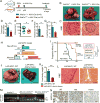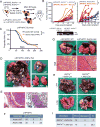Arid1a Has Context-Dependent Oncogenic and Tumor Suppressor Functions in Liver Cancer
- PMID: 29136504
- PMCID: PMC5728182
- DOI: 10.1016/j.ccell.2017.10.007
Arid1a Has Context-Dependent Oncogenic and Tumor Suppressor Functions in Liver Cancer
Erratum in
-
Arid1a Has Context-Dependent Oncogenic and Tumor Suppressor Functions in Liver Cancer.Cancer Cell. 2018 Jan 8;33(1):151-152. doi: 10.1016/j.ccell.2017.12.011. Cancer Cell. 2018. PMID: 29316428 Free PMC article. No abstract available.
Abstract
ARID1A, an SWI/SNF chromatin-remodeling gene, is commonly mutated in cancer and hypothesized to be tumor suppressive. In some hepatocellular carcinoma patients, ARID1A was highly expressed in primary tumors but not in metastatic lesions, suggesting that ARID1A can be lost after initiation. Mice with liver-specific homozygous or heterozygous Arid1a loss were resistant to tumor initiation while ARID1A overexpression accelerated initiation. In contrast, homozygous or heterozygous Arid1a loss in established tumors accelerated progression and metastasis. Mechanistically, gain of Arid1a function promoted initiation by increasing CYP450-mediated oxidative stress, while loss of Arid1a within tumors decreased chromatin accessibility and reduced transcription of genes associated with migration, invasion, and metastasis. In summary, ARID1A has context-dependent tumor-suppressive and oncogenic roles in cancer.
Keywords: ARID1A; SWI/SNF chromatin-remodeling complex; epigenetics; hepatocellular carcinoma; metastasis; mouse models.
Copyright © 2017 Elsevier Inc. All rights reserved.
Figures








Comment in
-
A Two-Faced mSWI/SNF Subunit: Dual Roles for ARID1A in Tumor Suppression and Oncogenicity in the Liver.Cancer Cell. 2017 Nov 13;32(5):542-543. doi: 10.1016/j.ccell.2017.10.014. Cancer Cell. 2017. PMID: 29136498
Similar articles
-
mTORC1 Promotes ARID1A Degradation and Oncogenic Chromatin Remodeling in Hepatocellular Carcinoma.Cancer Res. 2021 Nov 15;81(22):5652-5665. doi: 10.1158/0008-5472.CAN-21-0206. Epub 2021 Aug 24. Cancer Res. 2021. PMID: 34429326 Free PMC article.
-
Arid1a regulates response to anti-angiogenic therapy in advanced hepatocellular carcinoma.J Hepatol. 2018 Mar;68(3):465-475. doi: 10.1016/j.jhep.2017.10.028. Epub 2017 Nov 4. J Hepatol. 2018. PMID: 29113912
-
Decreased expression of ARID1A associates with poor prognosis and promotes metastases of hepatocellular carcinoma.J Exp Clin Cancer Res. 2015 May 15;34(1):47. doi: 10.1186/s13046-015-0164-3. J Exp Clin Cancer Res. 2015. PMID: 25975202 Free PMC article.
-
Molecular and pathological landscape of the AT-rich interaction domain 1A (ARID1A) mutation in hepatocellular carcinoma.Pathol Res Pract. 2025 Feb;266:155763. doi: 10.1016/j.prp.2024.155763. Epub 2024 Dec 9. Pathol Res Pract. 2025. PMID: 39706068 Review.
-
The emerging roles of ARID1A in tumor suppression.Cancer Biol Ther. 2014 Jun 1;15(6):655-64. doi: 10.4161/cbt.28411. Epub 2014 Mar 11. Cancer Biol Ther. 2014. PMID: 24618703 Free PMC article. Review.
Cited by
-
ARID1A-BAF coordinates ZIC2 genomic occupancy for epithelial-to-mesenchymal transition in cranial neural crest specification.Am J Hum Genet. 2024 Oct 3;111(10):2232-2252. doi: 10.1016/j.ajhg.2024.07.022. Epub 2024 Sep 2. Am J Hum Genet. 2024. PMID: 39226899 Free PMC article.
-
Multiple Facets of Cellular Homeostasis and Regeneration of the Mammalian Liver.Annu Rev Physiol. 2023 Feb 10;85:469-493. doi: 10.1146/annurev-physiol-032822-094134. Epub 2022 Oct 21. Annu Rev Physiol. 2023. PMID: 36270290 Free PMC article. Review.
-
The Role of the AT-Rich Interaction Domain 1A Gene (ARID1A) in Human Carcinogenesis.Genes (Basel). 2023 Dec 19;15(1):5. doi: 10.3390/genes15010005. Genes (Basel). 2023. PMID: 38275587 Free PMC article. Review.
-
Identification and validation of a five-gene prognostic signature for hepatocellular carcinoma.World J Surg Oncol. 2021 Mar 26;19(1):90. doi: 10.1186/s12957-021-02202-9. World J Surg Oncol. 2021. PMID: 33771191 Free PMC article.
-
Multi-site desmoplastic small round cell tumors are genetically related and immune-cold.NPJ Precis Oncol. 2022 Apr 4;6(1):21. doi: 10.1038/s41698-022-00257-9. NPJ Precis Oncol. 2022. PMID: 35379887 Free PMC article.
References
-
- Fujimoto A, Totoki Y, Abe T, Boroevich KA, Hosoda F, Nguyen HH, Aoki M, Hosono N, Kubo M, Miya F, Arai Y, Takahashi H, Shirakihara T, Nagasaki M, Shibuya T, Nakano K, Watanabe-Makino K, Tanaka H, Nakamura H, Kusuda J, Ojima H, Shimada K, Okusaka T, Ueno M, Shigekawa Y, Kawakami Y, Arihiro K, Ohdan H, Gotoh K, Ishikawa O, Ariizumi S-I, Yamamoto M, Yamada T, Chayama K, Kosuge T, Yamaue H, Kamatani N, Miyano S, Nakagama H, Nakamura Y, Tsunoda T, Shibata T, Nakagawa H. Whole-genome sequencing of liver cancers identifies etiological influences on mutation patterns and recurrent mutations in chromatin regulators. Nature Genetics. 2012;44:760–764. doi: 10.1038/ng.2291. - DOI - PubMed
MeSH terms
Substances
Grants and funding
LinkOut - more resources
Full Text Sources
Other Literature Sources
Medical
Molecular Biology Databases

